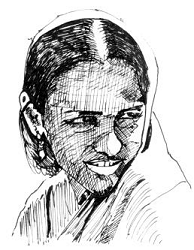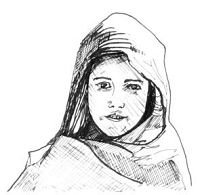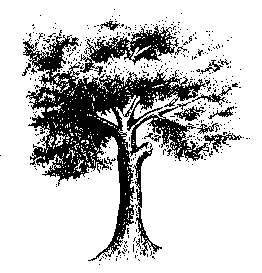Lesson Five
Dialogue five: Ladies’ talk
L: wáadu shiwe ye? Are you married? | وادٔ شوې یې؟ |
H: aw, shpug kaala kegee che waadu shiwe yim. Yes, it is six years since I have been married. | او، شپږ کاله کېږی چې وادهٔ شوې یم. |
L: bachee de khu dee? Are your children well? | بچی دې ښهٔ دی؟ |
H: aw, khu dee. Yes, they are well. | او ښهٔ دی. |
L: staa tso maashoomáan dee? How many children do you have? | ستا څو ماشُومان دی؟ |
H: masha'allah zmaa tsalór maashoomáan dee. I have four children, thank God. | ماشاءالله، زما څلور ماشُومان دی. |
H: yawa loor aw dre zaamún dee. One daughter and three sonse. | یوه لُور او درې زامن دی. |
L: shUkur day! Be grateful! | شکر دے. |
L: staa khaawúnd tsu kaar kawee? What job does your husband do? | ستا خاوند څهٔ کار کوی؟ |
H: haghá dUkaandáar day. He is a shopkeeper. | هغه دُوکاندار دے. |

NOTE:
The greetings used in previous lessons are left out in this and future dialogues – be sure to use them though.
Men’s talk
L: taa waadú kúRay day? Are you married? | تا وادهٔ کړے دے؟ |
H: aw, waadu me kúRay day. Yes, I'm married. | او، وادهٔ مې کړے دے. |
L: staa tso maashoomáan dee? How many children do you have? | ستا څو ماشُومان دی؟ |
H: zmaa yo zooy aw dwa jeenaakúy dee. I have one son and two daughters. | زما يو زوئ او دوه جينکۍ دى. |
H: aw staa? And you? | او ستا؟ |
L: na, waadú me nu day kúRay. No, I haven't married. | نه، وادۀ مې نۀ دے کړے. |
L: taaso tsu kaar kawey? What work do you do? | تاسو څهٔ کار کوئ؟ |
H: zu dookaandáar yim. I'm a shopkeeper. | زهٔ دُوکاندار یم. |
L: kaar tsínga rawáan day? How is business going? | کار څنګه روان دے؟ |
H: khu day. It's good. | ښه دے. |
NOTE:

When discussing marriage status (i.e., whether someone is married or not), men talk about “getting married” with a transitive verb وادهٔ کول - waadu kawul, while females talk about becoming married with an intransitive verb واده کېدل - waadu kedul.
Some professions
| naanbaa`ee | bread maker | نانبائی |
| naa`ee | barber | نائی |
| mazdóor | labourer | مزدُور |
| zameedáar | farmer | زمیدار |
| tsokeedáar | watchman | څوکیدار |
| benk waalaa | banker | بېنک والا |
| qasáab | butcher | قصاب |
| khaansaamá | cook | خانسامه |
| darzée | tailor | درزی |
| Daakée | postman | ډاکی |
| fojée | soldier | فوجی |
| sipaa`ee | policeman | سبائی |
| molaanáa | religious scholar | مولانا |
| tableeghée | preacher | تبلیغی |
| loháar | blacksmith | لوهار |
| zargúr | goldsmith | زرګر |
| chamyáar | cobbler | چمیار |
| gilkáar | mason | ګِلکار |
| tarkáaN | carpenter | ترکاڼ |
| shpoon | shepherd | شپون |
In some cases, the addition of the word توب - tob to the profession describes the activity undertaken. See the examples below:
| darzee | tailor | درزی |
| maalée | gardener | مالی |
| mUláa | mullah | مُلا |
| fojée | soldier | فوجی |
| shpoon | shepherd | شپون |
| darzeetób | tailoring | درزی توب |
| maaleetób | gardening | مالی توب |
| mUlaatób | work of a mullah | مُلا توب |
| fojeetób | soldiering | فوجی توب |
| shpoontób | shepherding | شپُون توب |
Pronunciaton Drill
- Contrasting ډ - D and د - d
| DoDuy shta? | Is food available? | ډوډۍ شته؟ |
| du dú tsu noom day? | What is his name? | د دۀ څۀ نُوم دے؟ |
| Duk ráawRa. | Bring it full. | ډک راوړه. |
| daa khu day. | This is good. | دا ښهٔ دے. |
| zRu me DaDa sho. | My heart became bold. | زړۀ مې ډاډه شو. |
| zRu me bud sho. | I became upset. | زړۀ مې بد شو. |
- Contrasting و - oo and u
| tu mazdóor ye? | Are you a labourer? | تۀ مزدُور يې؟ |
| táaso zargúr yey? | Are you [polite] a goldsmith? | تاسو زرګر يئ؟ |
| pu pUl poora dwa moTure zaayegee. | There is room for two cars on the bridge. | په پُل پُوره دوه موټرې ځائېږى. |
| pu haftá ke poora oowú wruze dee. | There are seven days in a week. | په هفته کښې پُوره اووۀ ورځې دى. |
Feminine pronouns
There are two feminine singular pronouns. For people in sight, دا - daa is used. For people who are 'over there' (i.e. far away or out of sight) هغه - haghá is used.
The equative becomes ده - da with 3rd person singular objects. For example, 'she is' becomes دا ده - daa da or هغه ده - haghá da depending on where the person is, in relation to you.
Feminine singular nouns
| Pronoun | Feminine noun | Verb | |
|---|---|---|---|
zu | DakTúra | yim. | I am a doctor. زهٔ ډاکټره یم. |
tu | Ustáaza | ye? | Are you a teacher? تۀ اُستاذه يې؟ |
daa | afghaaná | da? | Is she an Afghan? دا افغانه ده؟ |
haghá | pukhtaná | da. | She is a Pukhutn. هغه پښتنه ده. |
NOTE: The addition of ه - a to a noun indicates that it is feminine. You may also hear an extra ه - a added at the end of verbs to make a rhyme:
| zu DaakTúra yima | I (f.) am a doctor. | زهٔ ډاکټره یمه. |
Feminine singular adjectives
| Pronoun | Feminine adjective | Verb | |
|---|---|---|---|
zu | stúRe | yim. | I am tired. زۀ ستړې يم. |
tu | jóRa | ye? | Are you well? تۀ جوړه يې؟ |
daa | narúy | da. | She is thin. دا نرۍ ده. |
daa | drana | da. | daa drana da. دا درنه ده. |
haghá | khkÚle | da. | She is beautiful. هغه ښکُلې ده. |
haghá | gháTa | da. | She is big. هغه غټه ده. |
NOTE:
Adjectives are declined in one of the following ways: (Adjectives ending in ے - ay are declined differently depending if the accent is on the end of the word or not.)
| Big | Tired | Thin | |
|---|---|---|---|
m.s. | ghaT غټ | stúRay ستړی | naráy نرے |
f.s. | gháTa غټه | stúRe ستړې | narúy نرۍ |
Recognising feminine nouns and adjectives
The all-purpose ه - a
| taa sara speen churg shta? | Do you have a white cock? | تا سره سپين چرګ شته؟ |
| taa sara speena chúrga shta? | Do you have a white hen? | تا سره سپينه چرګه شته؟ |
| zmaa nars pukhtóon day. | My nurse (male) is a Pukhtun. | زما نرس پښتُون دے. |
| zmaa narsa pukhtaná da | My nurse (female) is a Pukhtun. | زما نرسه پښتنه ده. |
| day khatarnáak ghul day. | He is a dangerous thief. | دے خطرناک غل دے. |
| daa khatarnáaka ghla da. | She is a dangerous thief. | دا خطرناکه غله ده. |
Some nouns are always feminine
| daa Dera mazbóota wúna da. | This is a very strong tree. | دا ډېره مضبُوطه ونه ده. |
| daa Dera kharaaba maNa da. | This is a very rotten apple. | دا ډېره خرابه مڼه ده. |
| hagha jeenúy khkÚle da. | That girl is beautiful. | هغه جینۍ ښکُلې ده. |

Nouns ending with ۍ - uy
| daa almaarúy ghaTa da. | This wardrobe is big. | دا المارۍ غټه ده. |
| daa kUrsúy oochúta da. | This chair is tall. | دا کُرسۍ اُوچته ده. |
| hágha warkóTe spuy da. | That is a small bitch. | هغه ورکوټې سپۍ ده. |
| daa DoDúy mazedáara da. | This food is delicious. | دا ډوډۍ مزېداره ده. |
| dágha kiRkúy plúna da. | This window is wide. | دغه کړکۍ پلنه ده. |
Nouns ending in ې - e
| zu núway Ustáaz yim. | I am a new (male) teacher. | زۀ نوے اُستاذ يم. |
| zu núwe Ustáaza yim. | I am a new (female) teacher. | زۀ نوې اُستاذه يم. |
| staa malgúray ookhyáar day. | Your (male) friend is wise. | ستا ملګرے هوښيار دے. |
| staa malgúre ookhyáara da. | Your (female) friend is wise. | ستا ملګرې هوښياره ده. |
NOTE:
A masculine noun ending in ے - ay is made feminine by changing the ending to ې - e, or to ۍ - uy if the accent is on the last syllable.
Endings in و - o and ا - aa are feminine
| zmaa yawa khkÚle peesho shta. | I have one beautiful cat. | زما يوه ښُکلې پيشو شته. |
| zmaa niyaa hálta da. | My grandmother is there. | زما نيا هلته ده. |
| hágha ghwaa gháTa da. | That cow is big. | هغه غوا غټه ده. |
| zmaa babó dălta da. | My aunty is here. | زما ببو دلته ده. |
| Dera khandáa khu nu da. | Much laughter is not good. | ډېره خندا ښۀ نۀ ده. |
| Dera jzaRáa khu nu da. | Much crying is not good. | ډېره ژړا ښۀ نۀ ده. |
Feminine because of gender
| zmaa mor mihribáana da. | My mother is kind. | زما مور مهربانه ده. |
| staa tror booDúy da. | Your aunt is old. | ستا ترور بُوډۍ ده. |
| zmaa khor múshra da. | My sister is older. | زما خور مشره ده. |
| staa loor Dera khaaysta da. | Your daughter is very pretty. | ستا لُور ډېره ښائسته ده. |
NOTES:
All these nouns end in a consonant, and strictly speaking should be masculine – but natural gender overrules.
The adjective ښائسته - khaaysta (pretty) can also be used with masculine nouns.
Feminine nouns ending in ی - ee
| dostée kha da. | Friendship is good. | دوستی ښه ده. |
| dUshmanée kha nu da. | Enmity is not good. | دشمنی ښه نهٔ ده. |
Numbers eleven to twenty
👆 Write down the numbers as the teacher says them to you.
You may write them in English, or may wish to learn how to write the numbers in Pukhto. Don’t repeat the sentence, just listen and obay the command. Start with 1–10, and then add numbers up to 20.
| yowulus óoleeka! | Write eleven! | یوولس ولیکه! ۱۱ |
| dwolus óoleeka! | Write twelve! | دوولس ولیکه! ۱۲ |
| dyáarlus 13 | دیارلس ۱۳ |
| tswáarlus 14 | څوارلس ۱۳ |
| peenzúlus 15 | پینځلس ۱۵ |
| shpáaRus 16 | شپاړس ۱۶ |
| oowúlus 17 | اووهٔ لس ۱۷ |
| atúlus 18 | اتهٔ لس ۱۸ |
| nóolus 19 | نُولس ۱۹ |
| shul 20 | شل ۲۰ |
Memorizing moment
شعر - shi'ir (poem)
NOTE:
A شعر - shi'ir (poem) is rhyming poetry. The shi’ir selected for memory work are so well known that they act like proverbs in Pukhtun society.
متلونه - matalóona
Exercises for Lesson Five
- Replace the bold word in the question:
| staa tso bachee dee? | ستا څو بچی دی؟ |
- Change the following sentences into feminine ones:
- Substitute the bold word in this sentence, using the words listed below:
| haghá mez day. | هغه مېز دے. |
- Replace the bold word to make sentences:
| zmaa pu kor ke yuwa xudza da. | زما په کور کښې یوه ښځه ده. |
